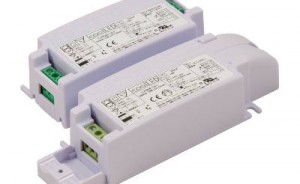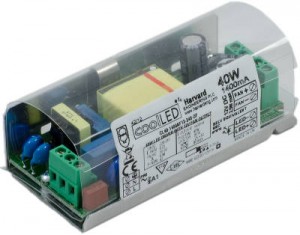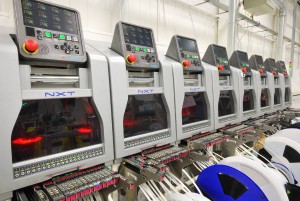LED Lighting Drivers for LED lighting
2013/08/14 While consumers are replacing their incandescent bulbs with LED copies, the professional world is turning to luminaires designed from scratch to use LEDs.
While consumers are replacing their incandescent bulbs with LED copies, the professional world is turning to luminaires designed from scratch to use LEDs.
The production model with these luminaires is the same as it is with fluorescent and high-intensity discharge (HID) lamps: put together metalwork, light source, optics, and a mains power supply.
To the lighting industry, the two new parts are a suitable PSU – known as a ‘ballast’ for HIDs and fluorescents, but a ‘driver’ for LEDs – and the LED source.
Unlike retrofit bulbs, which appear to be settling on one, or three LEDs, plus a cut-to-the-bone non-isolated driver, within professional luminaires manufacturers are getting increasingly adventurous: adopting almost every conceivable series and parallel arrangement of LEDs and asking for drivers to match them.
Harvard Engineering, established to make HID ballasts in 1993, has been designing and mass-producing LED lighting drivers under the CoolLED brand at its own site in Yorkshire since 2009, and has recently branched out into making light engines.
It has seen driver needs proliferate.
In the early days “a lot of LEDs around were 3W. Our initial design was a 700mA 33V driver switchable to 350mA”, company principle engineer Ken Dale told Electronics Weekly. “This expanded with drivers for 500mA and 1,000mA. We do them now from 250mA to 2.1A.”
‘Array’ or ‘cluster’ style LEDs with multiple die on a single ceramic tile 2-5cm across, like those from Bridgelux, are increasing demand for high current drivers at low voltage.
“Other people are making-up light source from small LED chips, with lower current for efficiency,” said Dale.
Where many LEDs are connected in series, designers are wise to keep the maximum string voltage to below 60V, said Dale, because above this, special safety precautions are required in the design.
When more than 60V is required, for example when two multi-LED light strings or light engines are connected in series, precautions might include better insulation between LEDs and heatsinks.
Also for safety, and unlike the drivers inside replacement bulbs, drivers for luminaires and remote mounting are fully-isolated with reinforced insulation (‘double insulated’), with no direct conductive path between mains and output.
Integrated or remote
Each driver family from Harvard generally come in two versions – integrated and remote – for building into luminaires or sitting alongside them.
“We did three styles – built-in, remote and flying leads as well. Flying leads are not so popular in Europe,” said Dale.
Remotely-mounted drivers are not uncommon, said Dale, sighting the example of high-bay lighting where one driver will feed several luminaires. Many professional down-lighters, like Cree’s recently-introduced 4,000 lm HID-replacing LMH2s, need a remote driver.
Dimming
Almost as soon as LED lighting appeared “people were requesting dimming”, said Dale, “so we designed in 1-10V and DALI dimming in same size and power rating.”
What about US-style 0-10V dimming?
“We started doing US products based on the ANSI 0-10V standard. But this is not what is used in general lighting in the US. In general US lighting, the 0-10V characteristic is very similar to [European] 1-10V, and one driver will meet both. ANSI 0-10V is used in some special applications, like stage lighting,” said Dale.
DALI is a digital dimming signal standard. Created before LED lighting was possible, is it still relevant?
“DALI is perfectly adequate. It’s easy to apply to LEDs, and they keep extending the standard,” said Dale. “We have just launched an new DALI range that dims from 100% to 1%.”
DMX, the other well-known digital dimming standard, remains mostly for stage lighting, said Dale.
Professional LED drivers do not escape the tyranny of legacy phase-cut analogue dimmers.
So Harvard does versions that will work with both leading-edge and trailing-edge dimmers in the same unit, achieving 100% to 5% with the majority of dimmers, said Dale.
Electrical design
Lighting LEDs have bought two things to the market: power efficiency, and life so long that 10 years of maintenance-free operation is possible. Choosing the wrong driver can ruin either or both.
“Efficiency in our drivers depends on power level. It is in the high 80%s, around 88%, and we have a new 150W driver that is 93% efficient including power factor correction,” said Dale. “Life is 50,000 hours for LEDs, so the design life for drivers is over 50,000 hours at operating temperature. Electrolytic capacitors are weakest link, we use long-life parts.”
 Dale mentioned power factor correction – PFC – the desire for which is gradually creeping down the power scale.
Dale mentioned power factor correction – PFC – the desire for which is gradually creeping down the power scale.
“We are always aiming for high efficiency and high power factor and long life,” he said. “Regulations say you don’t need PFC under 25W. But people doing large installations are still very interested in PFC, and harmonised standards are looking at PFC at 5W.”
Idiot-proofing
With its first ever LED driver, Harvard learned an important lesson.
“We built in protection, like thermal trip and output over-voltage, in the original driver. And we put a label on the outside warning not to connect them to the mains before the LEDs were connected,” said Dale. “And we still had problems with people applying mains, then connecting the LEDs, and the capacitors damaging the LEDs with a current surge.”
The second LED driver product had hot-plug protection – a current limit that protected LEDs from careless installation.
Wireless dimming
Wireless dimming allows dimmable lighting to be retrofitted without running new wires, and the cost of extra wiring to be saved in new-builds.
Its introduction, particularly for domestic installations, coincides with the rise of LED lighting, but it has been around for a while.
“We have a wireless system for streetlights called LeafNut, and for indoor we are working on a different system, called EyeNut,” said Dale.
Originally developed for HID and fluorescent streetlights, LeafNut uses the proprietary WiMAC protocol giving bidirectional control of 256 streetlights per hub on the licence-free 868MHz band.
The LeafNut communication module replaces the photocell mounted on top of most UK streetlamps.
Range is 1km and the hub uses GSM to communicate with the main server, said Dale. Users can set switching times and time intensity profiles, and warning of lamp failure is sent back to the server.
EyeNut is based on ZigBee. Further details remain under wraps until its official launch.
Light Engines
With the manufacture of light engines being a PCB-based process, and Harvard having an automated PCB production line on site, it was only a matter of time before the firm started making light engines.
It has chosen to make a limited range of standard engines as well as engines with custom LED positioning.
“A lot of the business is custom LED placement. There are a few standard ones: a 270×270 square module and some circular ones that fit in down-lighters that used compact fluorescent lamps. Four of the square ones will fit in a 600×600 panel,” said Dale.
Harvard Engineering – the company
Set-up in 1993, Harvard Engineering was founded to make ballasts for HID lighting.
“We still make electronic ballasts for HID lighting, and fluorescent lighting,” said company principle engineer Ken Dale. “Around four years ago, early in 2009, we started designing LED drivers. The first one was launched in late 2009.”
All products are designed and manufacture is in the UK on a single site in Normanton near Leads.
 “We are fairly automated to keep cost down, and we have an experienced purchasing team,” said Dale.
“We are fairly automated to keep cost down, and we have an experienced purchasing team,” said Dale.
Because production is on-site, the firm is able to offer modified standard products. “It is one of the strengths of Harvard, we can produce customised versions. It might be same circuit board with different components. We can do it from our experience and because of manufacturing locally. This is where we are different from Philips and Tridonic.”
The firm has “just shy of 300 people”, said Dale, including a total engineering workforce of over 50, which is growing because the company is recruiting.
Welcome to SUV System Ltd!
SUV System Ltd is ISO 90012008 Certified electronics distributor with 10 years of experiences.
We have built up long term business relationship with about many companies which are stockers and authorized agents. we have a steady and reliable supply to meet customer's demands to the greatest extent .Confidently, we are able to lower your cost and support your business with our years of professional service.
SUV System Ltd is Electronic Components Distributor Supplies,Find Quality Electronic Components Supplies Products IC(Integrated Circuits),Connectors,Capacitor,Resistors,Diodes,Transistors,LED at Suvsystem.com. Sourcing Other Energy, Environment, Excess Inventory Products from Manufacturers and Suppliers at Suvsystem.com
Electronic Components distributor:http://www.suvsystem.com
Connectors Distributor:http://www.suvsystem.com/l/Connectors-1.html
IC Distributor:http://www.suvsystem.com/l/IC(Integrated-Circuits)-1.html
LED Distributor:http://www.suvsystem.com/l/LED-1.html
Capacitor Distributor:http://www.suvsystem.com/l/Capacitor-1.html
Transistor Distributor:http://www.suvsystem.com/l/Transistors-1.html
Resistor Distributor:http://www.suvsystem.com/l/Resistors-1.html
Diode Distributor:http://www.suvsystem.com/l/Diodes-1.html
SUV System Ltd insists on the managing faith ofsincereness,speciality,foresight, win-win,so we build up stable-relationship customers located all over the world, including the States, Europe, Argentina, UAE, Malaysia, Australia,and India etc
we are focus on the following fields,and hope we can help you.
INFLNEON Diodes Metal Can Packages Transistors IC(Integrated Circuits) Low Ohmic Resistors Transistors Freescale Diodes Inc Diodes Dialight LED LITTELFUSE Diodes Industrial IC VISHAY IC Electronic News About US IDT IC INTERSIL IC Connectors NXP Diodes IR transistor Schottky Diodes Microchip IC Fairchild Semiconductor Transistors TI IC Multi-units Transistors PANASONIC chip Filter saws Chip Inductors Other Parts LINEAR IC ST Diodes NXP Transistors Switching Diodes Fast Recovery Diodes Xilinx IC Rectifier Diodes LED Resistor Arrays components Cypress IC FAIRCHILD diodes Digital Transistors
http://www.suvsystem.com/a/4912.aspx
没有评论:
发表评论